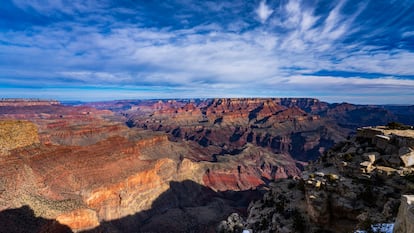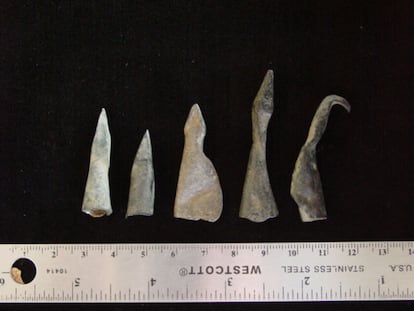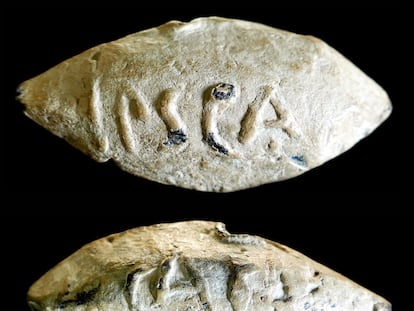Crossbow bolts and coins: The archaeological trail of the Coronado expedition that discovered the Grand Canyon
The conquistador Francisco Vázquez de Coronado y Guzmán crossed Arizona, New Mexico, Texas, Oklahoma and Kansas between 1540 and 1542 and left behind pieces that have been analyzed in a new study


In the film Indiana Jones and the Last Crusade (1989), the famous archaeologist played by actor Harrison Ford finds a jewel-encrusted crucifix in a cave in Utah that Spanish conquistador Hernán Cortés had given to fellow conquistador Francisco Vázquez de Coronado y Luján — the so-called Cross of Coronado. Although this gift never existed, there is a real basis for the story.
Between 1540 and 1542, Coronado left the Mexican city of Compostela and set out to find the mythical Seven Cities of Cíbola, where were said to be full of unparalleled riches. He traveled over a good part of what is now the United States and left an archaeological trail that has now been recovered by the study, Medieval Castilian Currency in the American Midwest.
The new article — by researcher Raúl Sánchez Rincón, from the Museum of Archaeology of Álava, and Iagoba Ferreira Benito, a historical reenactor — reveals the discovery of crossbow projectiles, clothes pins and medieval coins, that had been lost or left behind during Coronado’s expedition. Some 300 Spaniards — on horseback or on foot — and nearly 1,000 allied American Indians crossed the current states of Arizona, New Mexico, Texas, Oklahoma and Kansas. While the search for Seven Cities of Cibola was unsuccessful, the expedition discovered the Grand Canyon, a natural formation that was declared a World Heritage Site by UNESCO in 1979.
In recent years, ranchers and metal detectorists have found a series of metal objects in Blanco Canyon in Texas, including pierced coins from the time of Ferdinand IV of Castile (1295-1312), minted in Toledo, and another coin from a Castilian monarch from the House of Trastámara, probably from Henry III of Castile (1390-1406), minted in Burgos.
But that’s not all that was found: crossbow bolt heads made of copper, lead muzzleloader bullets (to feed shotguns through the barrel), small bronze cones (also called agujetas), horseshoes and horseshoe nails, belt buckles and glass beads have also been unearthed. “Among these materials there are several of great interest, related to clothing or offensive and defensive [military] equipment,” the study notes. According to the authors of the article, published in the history journal El Eco Filotélico y Numismático, these objects must have come from Coronado’s expedition.
The study attaches particular importance to “small copper-based alloy tubes with a pin that runs diametrically through one of their ends.” Their function, as reflected in abundant pictorial representations from the 15th and 16th centuries, was to reinforce the ends of the cords that were used to join garments (doublets and breeches) or to secure defensive pieces of chain mail.
The crossbow bolts found are similar to European crossbow points from that period, but are made from different material (copper instead of iron) and manufactured differently. They were worked from a flat piece of copper bent to the desired shape. Similar examples have also been found in the area of Albuquerque and Hawikuh (New Mexico), which is also associated with Coronado’s expedition. They were probably made in America due to the lack of supplies necessary to forge iron bolts on the continent. The conquistador Bernal Díaz del Castillo wrote that during the siege of Tenochtitlan in 1521 the Spanish managed to make 50,000 of these bolts in just eight days.
In another area near the site — called Jimmy Owens, named after the first detectorist who found it — a chain mail glove was found. The experts believe this could have been “medieval and Renaissance” protection for an unarmed left hand. The authors argue that the glove could have prevented the soldier being cut when deflecting the enemy’s blade or grabbing it. It only covers three fingers.
At the time of Coronado’s expedition, this type of protection was no longer used in Europe, but it was used in America. There is evidence that 200 chain mail coats were sent to present-day Jamestown (Virginia) in 1622. However, the damage caused to the site by looters makes it impossible to date it and to determine the exact location of the find and its archaeological context. Perhaps it is no more than a 100 years old and is from a nearby cattle farm. “What surprises us,” say the researchers, “is that it is in a very good state of preservation, despite the 500 years that have passed [since the expedition].”
On their journey in pursuit of the Seven Cities of Cíbola — also known as the Seven Cities of Gold —, Coronado and his men explored the territories of northern Texas, locating new cities and lands, some as emblematic as the Grand Canyon, which was discovered by one of the men on the expedition, García López de Cárdenas. The account of the expedition was collected by the soldier Pedro Castañeda de Nájera, who provided details on all kinds of geographical and ethnographic data on territories and peoples that were unknown until then. They were the first Europeans to see bison, as well as the Grand Canyon.

On the route that led them to the city of Quivira (Kansas), Coronado’s expeditionary force crossed what is now Texas, where, according to the preserved documentation, they established two camps on two ravines. The first was located near a village of the Teya Indians and was hit by a severe hailstorm that caused significant property damage and led several horses to escape. In the second, the contingent remained for a couple of weeks hunting bison, while Coronado and a small group ventured further north.
The study states that “the two late medieval Castilian-Leonese coins found are the ones that spark the most doubts and offer the greatest mysteries.” In the absence of archaeological context and information regarding the circumstances in which the pieces were found, the researchers put forward two hypotheses. “The most logical and probable is that they traveled in the pockets of some members of the [Coronado] expedition in order to be used as a means of exchange with the Natives or as a gift.” The second hypothesis is that the two coins arrived through the commercial exchange that the Teya Indians maintained with other nearby peoples, who had previously come into contact with the Spanish.
“As is the norm with metal detector finds, in addition to losing the contextual information associated with the pieces, they are not usually collected in a systematic and protocolized way, which causes the loss of very valuable data for future research,” the experts complain. The materials — or very possibly only part of them — have been deposited at the Floyd County History Museum in Texas.
Sign up for our weekly newsletter to get more English-language news coverage from EL PAÍS USA Edition
Tu suscripción se está usando en otro dispositivo
¿Quieres añadir otro usuario a tu suscripción?
Si continúas leyendo en este dispositivo, no se podrá leer en el otro.
FlechaTu suscripción se está usando en otro dispositivo y solo puedes acceder a EL PAÍS desde un dispositivo a la vez.
Si quieres compartir tu cuenta, cambia tu suscripción a la modalidad Premium, así podrás añadir otro usuario. Cada uno accederá con su propia cuenta de email, lo que os permitirá personalizar vuestra experiencia en EL PAÍS.
¿Tienes una suscripción de empresa? Accede aquí para contratar más cuentas.
En el caso de no saber quién está usando tu cuenta, te recomendamos cambiar tu contraseña aquí.
Si decides continuar compartiendo tu cuenta, este mensaje se mostrará en tu dispositivo y en el de la otra persona que está usando tu cuenta de forma indefinida, afectando a tu experiencia de lectura. Puedes consultar aquí los términos y condiciones de la suscripción digital.
More information
Archived In
Últimas noticias
Petro claims the ELN was the target of US attack in Venezuela
Maduro counterattacks Trump with rhetoric and announces downing of nine drug trafficking aircraft
‘Ecce Homo’: The miraculous disaster that made a small Spanish town famous
Return to sex testing at the Olympics: IOC edges closer to banning transgender women
Most viewed
- Sinaloa Cartel war is taking its toll on Los Chapitos
- Oona Chaplin: ‘I told James Cameron that I was living in a treehouse and starting a permaculture project with a friend’
- Reinhard Genzel, Nobel laureate in physics: ‘One-minute videos will never give you the truth’
- Why the price of coffee has skyrocketed: from Brazilian plantations to specialty coffee houses
- Silver prices are going crazy: This is what’s fueling the rally










































